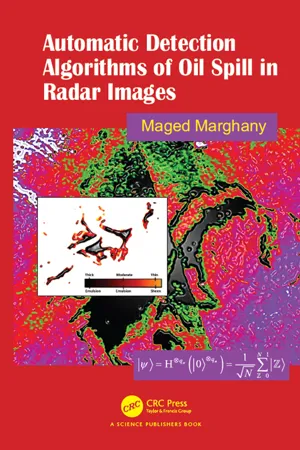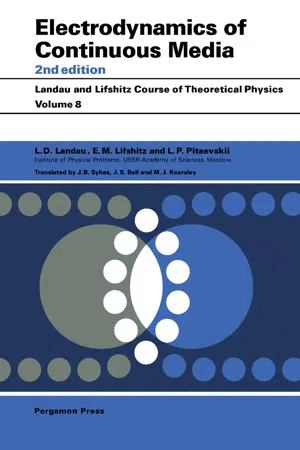Physics
Scattering Angle
The scattering angle refers to the angle between the incident direction of a particle or wave and the direction in which it is scattered after interacting with a target, such as an atom or nucleus. It is a crucial parameter in understanding the behavior of particles and waves in various scattering processes, providing valuable information about the nature of the interaction.
Written by Perlego with AI-assistance
Related key terms
Related key terms
1 of 4
Related key terms
1 of 3
6 Key excerpts on "Scattering Angle"
- eBook - ePub
- David Bohm(Author)
- 2012(Publication Date)
- Dover Publications(Publisher)
PART V
THEORY OF SCATTERING
Passage contains an image
CHAPTER 21
1. Introduction. Whenever a beam of particles of any kind is directed at matter, the particles will be deflected out of their original paths as a result of collision with the particles of matter which they encounter. The problem of studying this scattering process is important for two reasons: First, a great many interesting effects, such as the stopping of electrons in gaseous discharges, the collisions of gas molecules, and the stopping of radioactive and cosmic ray particles, are all determined, at least in part, by the probability of scattering. Second, and perhaps even more important, is the fact that from a detailed study of the results of scattering, much can be learned about the nature of the particles that are being scattered, and as well as of those that are doing the scattering. A large part of our knowledge of atomic and nuclear physics has come from studies of just such measurements.2. Classical Theory of Scattering. The early idea of an atom was of a perfectly elastic object, more or less spherical in shape. Since the atoms of a gas are moving in random directions, they must occasionally collide with each other and thus suffer deflections in their directions of motion. The probability of collision depends on three factors: the density of molecules, their sizes, and their mean velocities.If the molecules are spherical in shape, with a radius a , a collision will occur whenever the centers of two molecules come closer than d = 2a . To compute the probability that in the short time dt a given particle collides with another, consider a cylinder with a base of area of πd 2 and height equal to the distance dx = υ dt traveled by the particle during this time. The probability of collision is then just equal to the probability that the center of another particle lies in this cylindrical region. In terms of the particle density ρ - Maged Marghany(Author)
- 2019(Publication Date)
- CRC Press(Publisher)
4Quantum Mechanical of Scattering Cross-Section Theory
ABSTRACT: Scattering is the keystone to understand the mechanism of radar imaging. The conventional way of scattering is well addressed in many literature reviews. However, there is a new approach to comprehending the scattering mechanisms. This chapter delivers a new approach based on quantum mechanics. In this view, the Feynman concept for scattering is introduced. Moreover, the chapter has also demonstrated the dependence of the scattering theory on the spin. In this regard, this chapter delivers the correlations between scattering and wavefunction. For more details, the scattering theory is also tackled from the view of quantum particles.4.1 Definitions of Scattering
Scattering is a general physical process where some forms of radiation, such as light, sound or moving particles, are forced to deviate from a straight trajectory by one or more path due to localized non-uniformities in the medium through which they pass. In this regard, the quantum mechanics describe the scattering as a function of atom-photon interaction. In this understanding, the definite detected targets are two incident photons with a certain energy, and two deviate photons with different energies. In this context, the probability of such a process (given the incident and the deviation) to occur is determined by the amplitude associated with this particular Feynman graph (Fig. 4.1 ). It is also worth noting that such a probability is not completely accurate since a single diagram is just one term of the infinite formal perturbative expansion providing the transition amplitude. However, it must not interpret the Feynman graph as a collision process. Figure 4.1 reveals that Positron 1 absorbs B and becomes positron 4, which emits C and becomes positron 3. Furthermore, electron 2 and positron 3 annihilate and producing D [52 , 53 , 54 , 55- eBook - ePub
- Anupam Garg(Author)
- 2012(Publication Date)
- Princeton University Press(Publisher)
22 Scattering of electromagnetic radiationWhen electromagnetic radiation falls on a medium, the charges in the medium are accelerated and themselves radiate electromagnetic waves. In some cases, dielectrics, e.g., this reradiation combines with the original radiation in such a way as to lead to wave propagation, and the problem is analyzed using the language of the refractive index and the frequency-dependent dielectric function. If instead of a bulk medium, we have a small piece of matter, or even a single charge, the reradiation is said to arise from scattering of the incident wave. Scattering is an enormously important tool in the analysis of material media, as evidenced by the sheer variety of names: Thomson, Rayleigh, Compton, X-ray, Brillouin light scattering, Raman, etc. In this chapter, we study some of these.Our task is complicated by the fact that the ultimate description of matter, and even of radiation, must be quantum mechanical. This aspect is especially important when the frequency of the radiation becomes comparable to the internal frequencies of atoms. Absorption and emission then take place at definite spectral frequencies, a fact that classical mechanics cannot explain. Even at low frequencies, the polarizabilites of atoms and molecules must eventually be found by quantum mechanics. At very high frequencies, the quantal nature of light becomes important, as in the Compton effect. Nevertheless, there is a wide range of phenomena where classical physics is applicable, and even where it fails in the details, it provides a valuable way of thinking about the problem.145 Scattering terminology
The basic descriptor of scattering is the cross section , σ , defined as the power scattered divided by the incident energy flux:FIGURE 22.1. Scattering descriptors.Since the energy flux is the energy passing unit area in unit time, the cross section has dimensions of area. By considering the scattered radiation in an infinitesimal solid angle around a given direction, we obtain the differential scattering cross section , denoted dσ/d - eBook - ePub
- Debora Berti, Gerardo Palazzo(Authors)
- 2014(Publication Date)
- Elsevier(Publisher)
Figure 8.4 .Figure 8.4 Interference arising from two scattering centers within the same particle.By comparing Figures 8.3 and 8.4 , one recognizes that this phase shift is , with the vector joining the two scattering centers, i.e., the distance between the scatterers.The amplitude at distance R ′ far from the scatterer will be then given by(8.5)We recognize that the summation term contains a factor dependent on the chemical nature of the sample and on the physics of interaction with the radiation (bi ) and a factor that contains the information on distance between scattering centers, where the q -dependence of A is explicitly introduced.The expression can be extended to N point scatterers; detectors measure intensity, i.e., the absolute square of the amplitude, proportional to the number of photons or neutrons scattered in a given direction specified by q . This normalized scattered intensity will be(8.6)The interference pattern measures the probability of finding an atom of scattering lengthWe will not review here all the mathematics involved in the derivation of the absolute scattering intensity, referring the reader to more specialized textbooks, mentioned at the end of the chapter.biand another one of scattering lengthbkat a distancerjk.The b i s are called scattering lengths and are tabulated for each atom for both X-rays and neutrons. Therefore, once the chemistry of the scatterer is known, they can be easily evaluated. In small-angle scattering (i.e., q max - eBook - ePub
- L D Landau, J. S. Bell, M. J. Kearsley, L. P. Pitaevskii, E.M. Lifshitz, J. B. Sykes(Authors)
- 2013(Publication Date)
- Pergamon(Publisher)
CHAPTER XVSCATTERING OF ELECTROMAGNETIC WAVES
Publisher Summary
This chapter discusses the scattering of electromagnetic waves. Scattering is due to the change in the motion of the charges in the medium under the influence of the field of the incident wave, resulting in the emission of the scattered waves. The basic scattering process consists in the absorption of the original quantum by the scattering system and the simultaneous emission by that system of another quantum. The frequency of the scattered quantum may be either less or greater; these two cases are called Stokes scattering and anti-Stokes scattering, respectively. In the former case, the system absorbs an amount of energy; in the latter case, it emits energy and makes a transition to a state of lower energy. In the simple case of a gas, scattering takes place at individual molecules and the change in frequency may be due to either a transition of the molecule to another energy level or to a change in the kinetic energy of its motion. Two types of scattering can be distinguished, depending on the change in frequency of the light: (1) Raman scattering and (2) Rayleigh scattering. Raman scattering in gases results from a change, due to the incident light, in the vibrational, rotational, or electronic state of the molecule. Rayleigh scattering, on the other hand, does not involve a change in the internal state of the molecule. - eBook - ePub
Charged Particle Optics Theory
An Introduction
- Timothy R. Groves(Author)
- 2017(Publication Date)
- CRC Press(Publisher)
ϑ.We define the normalized incident wave function u0 (x) as the plane wave(4.72) We assume the observation point P is located far from the scattering center. As such, the scattered wave u(x) can be approximated by a spherical wave,(4.73) where we define r = |x|, and the factor f(k0 , k) is called the scattering amplitude.Strictly, the incident plane wave has infinite extent. However, in practice the incident beam is typically collimated, so that the incident and scattered waves do not interfere at the observation point P. We write the incident flux S0 and the scattered flux S, respectively as(4.74) where v0 and v are the incident and scattered velocities, respectively. For the case of elastic scattering, v = v0 . It follows immediately that the differential cross section is (4.73 , 4.74 )(4.75) We define a total wave function ut (x) = u0 (x) + u(x) as the sum of the incident and scattered wave functions. This must satisfy Schrödinger’s equation,(4.76) where U(x) is the potential energy associated with the scattering center, and(4.77) where H is the continuous total energy eigenvalue associated with the state ut . This is recognizable as the Helmholtz equation. It is inhomogeneous, owing to the source term on the right-hand side.From the previous section, this equation can be expressed in integral form as(4.78) where G(x, x1 ) is the Green’s function given by(4.79) The scattering potential energy U(x1 ) is appreciably different from zero over a very small region x1 . As the observation point P is very far away, we assume r ≫ r1 , where we define r ≡ |x| and r1 = |x1
Index pages curate the most relevant extracts from our library of academic textbooks. They’ve been created using an in-house natural language model (NLM), each adding context and meaning to key research topics.
Explore more topic indexes
Explore more topic indexes
1 of 6
Explore more topic indexes
1 of 4





